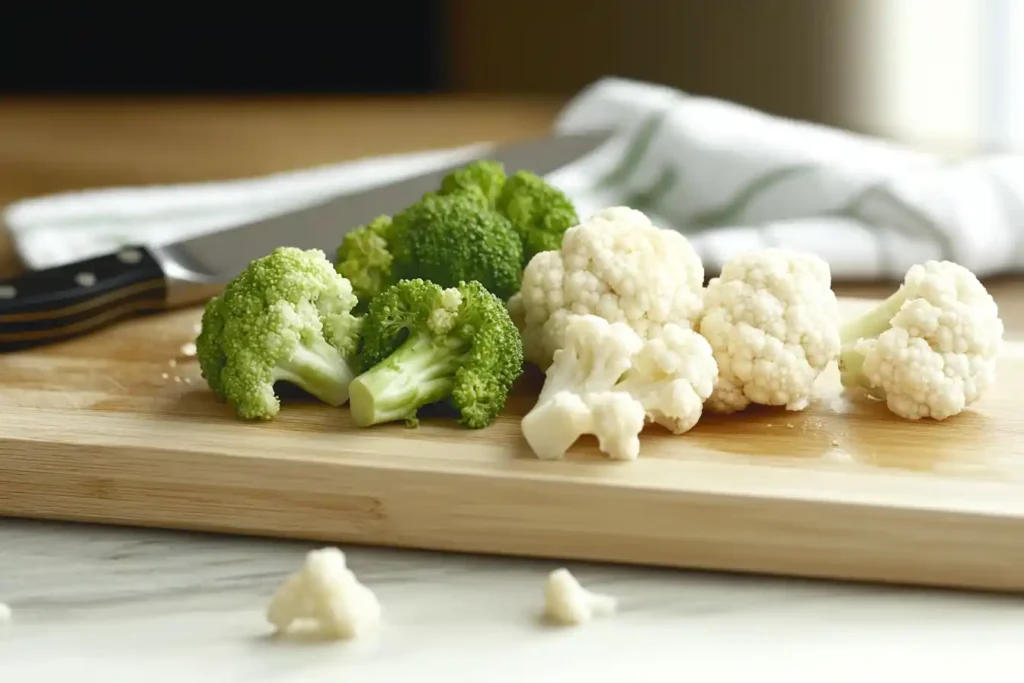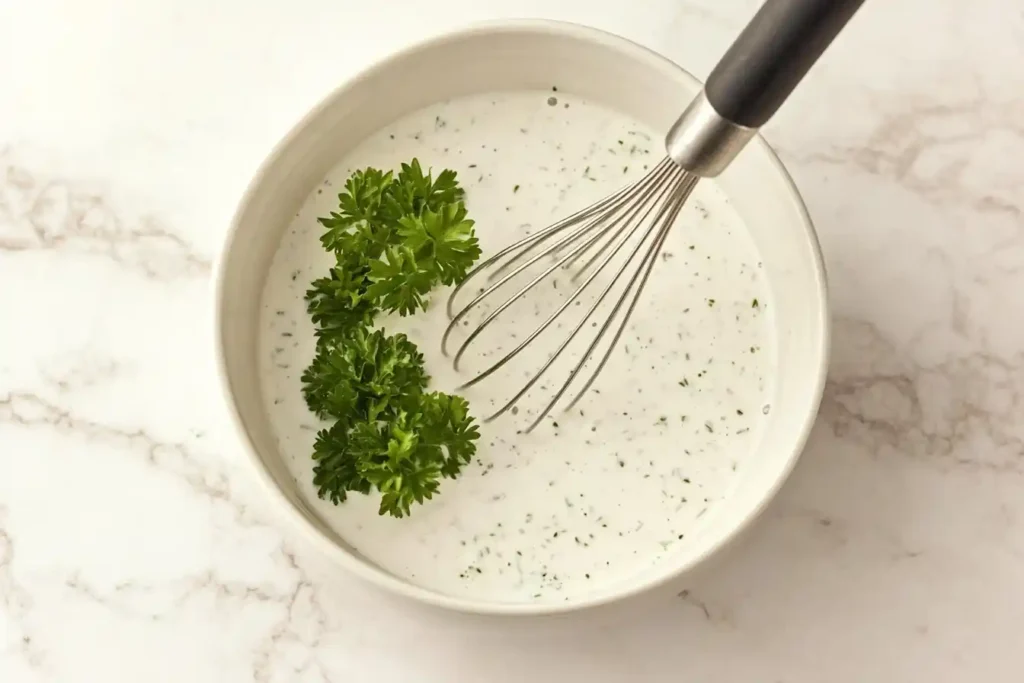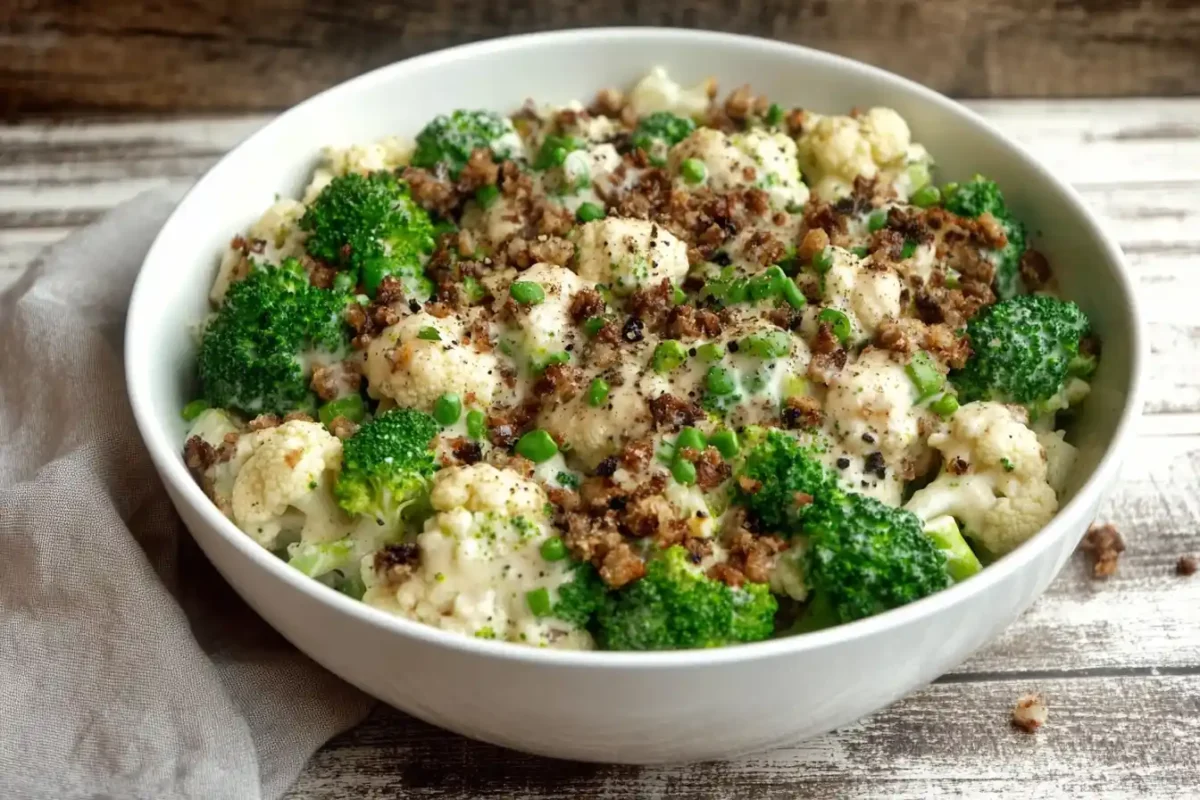Introduction to the Ultimate Broccoli Cauliflower Salad Recipe
When it comes to crowd-pleasing dishes, the broccoli cauliflower salad recipe is a showstopper! It’s not just about the incredible flavors, but also how it brings a nutritional punch to the table. Imagine the crispy crunch of fresh vegetables paired with a creamy, tangy dressing. Plus, with an endless variety of toppings like nuts, seeds, and shredded cheese, this salad becomes a versatile addition to your meal plans.
Not only is it quick to whip up, but it also caters to various diets, making it perfect for gatherings or as a wholesome side dish. Whether you’re a seasoned cook or just stepping into the kitchen, this recipe’s simplicity ensures you’ll nail it every time. What’s more, its ability to be customized means you can tweak it to match your personal taste.
So, whether you need a reliable salad for meal prep or a vibrant centerpiece for your next family dinner, this salad has you covered! Let’s delve deeper into the fresh ingredients that make it such a favorite.
Ingredients Breakdown

Fresh Vegetables
Broccoli
Broccoli is the heart of this broccoli cauliflower salad recipe, bringing a crisp texture and an abundance of nutrients. Packed with vitamins C and K, along with antioxidants, it’s a powerhouse for boosting immunity and improving digestion. When selecting broccoli, look for firm, tightly packed florets that are deep green in color—yellowing or soft spots indicate it’s past its prime.
Cauliflower
Cauliflower is equally impressive in terms of health benefits. It’s low in calories but high in fiber, supporting both weight management and gut health. Moreover, its mild flavor acts as a perfect balance to broccoli’s bold taste. To choose the best cauliflower, opt for heads that are creamy white, heavy for their size, and free from brown spots. The green leaves should look fresh, not wilted.
Additional Components
Cheese
Cheese adds a rich, indulgent touch to the salad, making it feel hearty and satisfying. Cheddar works wonderfully, offering sharpness that complements the creamy dressing. Parmesan can be another great option for a nuttier flavor. As for the quantity, a handful of shredded cheese is usually sufficient, but feel free to adjust based on your preferences.
Nuts and Seeds
For a bit of crunch and extra nutrients, nuts and seeds are indispensable. Sunflower seeds are a classic choice, delivering a nutty, roasted flavor. Slivered almonds or even cashews work beautifully, too, depending on the vibe you’re aiming for. They’re also excellent sources of healthy fats, enhancing the salad’s nutritional value.
Dressing Ingredients
Mayonnaise Base
A creamy mayonnaise dressing is what ties this salad together. It creates a luscious texture that clings to every bite, ensuring the flavors are well-distributed. If you’re looking for healthier alternatives, you can substitute mayonnaise with Greek yogurt or avocado puree, both of which offer creaminess without compromising nutrition.
Vinegar Selection
Vinegar adds the tangy zing that balances out the richness of the dressing. White vinegar works well for a neutral tang, but apple cider vinegar or red wine vinegar can elevate the flavor profile with subtle fruity notes. Choose one that complements your personal taste.
Sweeteners
A touch of sweetness rounds out the dressing’s flavor profile. Classic white sugar is often used, but alternatives like honey or maple syrup can add complexity and a natural sweetness. Use just enough to offset the tang of the vinegar and the creaminess of the mayo without overpowering the dish.
Preparation Steps For Broccoli Cauliflower Salad

Prepping the Vegetables
Washing and Cutting
Start by thoroughly rinsing both broccoli and cauliflower under cold water to remove dirt or pesticides. After that, pat them dry with a clean kitchen towel to ensure no excess water dilutes the salad. Cut the vegetables into small, bite-sized florets for even distribution and ease of eating. A uniform size not only makes the salad visually appealing but also ensures each bite has a perfect balance of flavors.
Blanching (Optional)
If you prefer slightly softer broccoli and cauliflower, blanching is an excellent step. To do this, boil a large pot of salted water and prepare an ice bath on the side. Drop the florets into the boiling water for 1-2 minutes, then quickly transfer them to the ice bath to stop the cooking process. This technique keeps the vegetables bright and crunchy while mellowing out their raw taste.
Cooking the Bacon
Stovetop Method
Cooking bacon on the stovetop is quick and straightforward. Heat a skillet over medium heat, add the bacon slices, and cook until they’re crispy, flipping occasionally for even browning. Place them on paper towels to absorb the grease before crumbling them into the salad.
Oven-Baked Method
For a hands-off approach, baking bacon in the oven is ideal. Preheat your oven to 400°F (200°C), line a baking sheet with parchment paper, and lay the bacon strips in a single layer. Bake for 15-20 minutes, depending on your desired crispiness. Once cooled, crumble them into small pieces for a crunchy topping.
Assembling the Salad
Combining Ingredients
Start by arranging the broccoli, cauliflower, cheese, nuts, and any other optional add-ins in a large mixing bowl. Additionally, layer the ingredients strategically to ensure they are evenly distributed, creating a harmonious blend of flavors in every bite.
Moreover, this technique allows the toppings to remain visible, enhancing the salad’s presentation while also simplifying the mixing process. As a result, each serving is consistent, colorful, and packed with the perfect combination of textures and tastes.
Mixing the Dressing
In a smaller bowl, whisk together the mayonnaise, vinegar, and sweetener until the dressing reaches a smooth, creamy consistency. Taste and adjust the sweetness or tanginess as needed to suit your preference.
Tossing Techniques
Begin by pouring the dressing evenly over the salad ingredients, ensuring it is distributed across all components for a balanced taste. Next, use salad tongs or a large spoon to gently toss everything together, taking care not to damage the delicate vegetables.
Additionally, be sure to mix thoroughly so that each piece is well-coated with the dressing, enhancing the flavor in every bite. As a result, the salad achieves a harmonious blend of textures and tastes, making it both visually appealing and deliciously satisfying.
Serving Suggestions
Understanding the nutritional content of your broccoli cauliflower salad recipeis crucial for maintaining a balanced diet. Here’s a breakdown of the approximate nutritional values for broccoli cauliflower salad
Nutritional Information (Per 100g)
| Nutrient | Amount |
|---|---|
| Calories | 120 kcal |
| Protein | 5 g |
| Fat | 9 g |
| Carbohydrates | 6 g |
| Fiber | 3 g |
| Sugar | 2 g |
| Sodium | 150 mg |
Ideal Pairings
Main Courses
The broccoli cauliflower salad recipe shines as a versatile side dish that pairs beautifully with a variety of main courses. It complements grilled chicken, roasted turkey, or even pan-seared fish by balancing out the savory proteins with its crisp freshness. For vegetarian meals, this salad is a great addition alongside dishes like lentil patties or stuffed bell peppers, adding texture and nutritional variety.
Beverages
To round out the meal, consider drinks that enhance the flavors of the salad. Freshly squeezed lemonade or a sparkling water infused with citrus can provide a refreshing contrast to the creamy dressing. Herbal iced teas, like mint or chamomile, are light enough to accompany the vibrant flavors without overwhelming your palate.
Presentation Tips
Plating
A little attention to plating can turn this broccoli cauliflower salad into a visual masterpiece. Use a large, shallow serving dish to spread the salad out, allowing the vibrant green of the broccoli and the creamy white cauliflower to stand out. Layer the salad ingredients strategically so that colorful components, like shredded cheese or nuts, are visible on the surface. This makes the dish look inviting and appetizing.
Garnishing
The final touch matters! Sprinkle fresh herbs like parsley or dill on top to add a pop of color and a hint of freshness. For extra crunch, scatter a handful of nuts or seeds just before serving. If you want a burst of flavor, a light drizzle of honey or a few grinds of black pepper can elevate the presentation and taste, making the salad irresistible.
Variations and Dietary Adjustments
Vegetarian and Vegan Options
Plant-Based Protein Alternatives
For those following a vegetarian or vegan diet, there’s no need to miss out on this delightful broccoli cauliflower salad recipe. You can swap out animal-based proteins like bacon with plant-based alternatives such as smoky tempeh, crispy chickpeas, or even coconut flakes toasted with liquid smoke. These substitutes bring flavor and crunch while keeping the recipe plant-friendly.
Non-Dairy Cheese Options
For a dairy-free twist, opt for plant-based cheeses made from cashews, almonds, or coconut. Nutritional yeast is another excellent choice, offering a cheesy flavor with added B vitamins. Adjust the quantity to maintain the creaminess of the dish.
Low-Calorie Modifications
Light Dressing Choices
For a lighter, creamy dressing, consider replacing the mayonnaise base with Greek yogurt, which adds tanginess and reduces calories. Alternatively, you can opt for a combination of mashed avocado and freshly squeezed lime juice, creating a flavorful and nutrient-rich alternative. Furthermore, these substitutions not only cut down on fat content but also enhance the overall nutritional profile of the salad. As a result, you achieve a creamy texture without compromising on taste or health benefits. Whether you choose yogurt or avocado, both options blend seamlessly with the other dressing ingredients, ensuring a perfectly balanced flavor in every bite.These alternatives reduce calories while keeping the dressing flavorful and rich.
Reducing Calorie-Dense Ingredients
Cheese and nuts are delicious but can be calorie-dense. Use reduced-fat cheese and scale back the quantity of nuts while still enjoying their texture. Incorporating crunchy vegetables like carrots or bell peppers can add bulk without additional calories.
Gluten-Free Adaptations
Ensuring Gluten-Free Ingredients
Most of the ingredients in this salad are naturally gluten-free, but it’s always wise to double-check product labels. For example, make sure dressings or store-bought seeds are certified gluten-free to avoid any hidden gluten.
Crunchy Gluten-Free Additions
Instead of croutons or other wheat-based toppings, try adding gluten-free roasted chickpeas or seeds. These add texture and crunch without compromising dietary restrictions.
Storage and Make-Ahead Tips
Refrigeration Guidelines
Optimal Storage Containers
To keep your salad fresh, store it in an airtight container. Glass containers are particularly good as they help retain the crispness of the vegetables. Avoid using containers that don’t seal tightly, as air exposure can make the salad soggy.
Shelf Life
When properly stored in the fridge, this broccoli cauliflower salad recipe can last for up to 3 days. However, the fresher the salad, the better the texture and taste. For optimal flavor, consume it within 24 hours of preparation.
Preparing in Advance
Separating Components
To prevent the salad from becoming watery, store the dressing and the salad ingredients separately if you’re preparing it ahead of time. Mix them just before serving to maintain the crunchiness of the vegetables.
Assembling Before Serving
When you’re ready to serve, combine the prepped salad ingredients and toss them with the dressing. This last-minute assembly ensures that the salad retains its texture and looks vibrant when served.
Frequently Asked Questions About Broccoli Cauliflower Salad
Broccoli and cauliflower are both cruciferous vegetables, meaning they come from the same family. While they share a similar structure, their flavors are slightly different. Broccoli has a more pronounced, earthy taste, whereas cauliflower is milder and nuttier. When combined, they complement each other beautifully, creating a balance of flavor and texture that’s perfect for salads. This combination also doubles the nutritional benefits, as both are rich in fiber, vitamins, and antioxidants.
The healthiest way to enjoy broccoli and cauliflower is raw or lightly cooked to preserve their nutrients. Raw florets maintain their full fiber content and provide a satisfying crunch, making them ideal for salads. If you prefer them cooked, steaming or blanching is the best option, as it helps retain essential vitamins like C and K while enhancing their natural flavor. Avoid overcooking, as it can reduce nutrient levels and affect their texture.
Absolutely! Broccoli can be eaten raw in a salad and is a great way to enjoy its crisp texture and fresh taste. Raw broccoli is also packed with nutrients like vitamin C, which can diminish during cooking. To ensure the best flavor and digestibility, chop the broccoli into small florets or thin slices. Some people may find raw broccoli a bit tough, so massaging it with a bit of lemon juice or salt can help soften it slightly.
Blanching broccoli is an optional step that enhances its color, texture, and flavor while making it easier to digest. When you blanch broccoli for a salad, it softens slightly without losing its crunch. The process involves briefly boiling the florets and then plunging them into an ice bath to stop the cooking. This method helps retain the vibrant green color and ensures the broccoli is tender-crisp—perfect for salads where presentation and texture matter.
Conclusion Of Broccoli Cauliflower Salad
The broccoli cauliflower salad recipe is a delightful combination of flavor, nutrition, and versatility. Whether you’re looking for a vibrant dish for a family dinner, a potluck favorite, or a healthy side to add to your meal prep, this recipe checks all the boxes. The crisp vegetables, creamy dressing, and optional crunchy toppings make it both satisfying and customizable for any dietary preference or occasion.
By following the simple steps outlined here, you can create a salad that’s not only visually stunning but also bursting with taste and nutrients. From fresh, nutrient-packed broccoli and cauliflower to creative dressing options and fun add-ins, this salad allows you to explore endless variations while keeping it healthy and delicious.
So, gather your ingredients, whip up this crowd-pleaser, and enjoy every bite of this refreshing and wholesome dish. It’s proof that eating your veggies can be both fun and absolutely delicious!
For more inspiration and creative ideas, don’t miss our latest article:”Taco Soup Frios“. It’s packed with fresh recipes and tips to make your cooking experience even more enjoyable!
For more inspiration and creative ideas, don’t miss our latest article:”Burger Bowl“. It’s packed with fresh recipes and tips to make your cooking experience even more enjoyable!”

